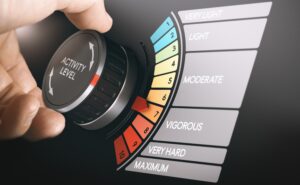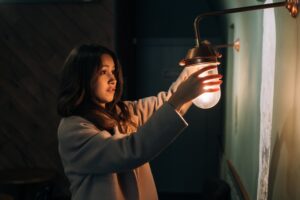The ideal light color temperature for product photography is between 5000K and 6000K. This range mimics natural daylight, providing illumination that highlights vibrant colors and fine details. When you use this temperature, your images will showcase the true colors of your products, creating a more appealing visual story.
Make sure to set your camera’s white balance to match your light source for accurate results. Soft, diffused lighting helps minimize harsh shadows while experimenting with light positions and modifiers can enhance your setup. Discovering the perfect approach can elevate your photography skills even further.
Key Takeaways
- Aim for a color temperature between 5000K and 6000K to achieve vibrant colors that mimic natural daylight.
- Set the white balance to match your light source for accurate color representation.
- Use soft, diffused light to reduce harsh shadows and enhance product details.
- Incorporate light modifiers like softboxes to achieve even illumination throughout your setup.
- Maintain consistent lighting to avoid unwanted color casts and ensure a cohesive visual story.
Understanding The Light Color Temperature for Product Photography
Color temperature plays an essential role in product photography, influencing how colors are perceived in your images.
When you adjust your lighting setup, you’re dictating the mood and tone through color temperature, which is measured in Kelvin (K). For instance, cooler temperatures (above 5000K) create a bluish hue, while warmer temperatures (below 3000K) produce a yellowish or reddish tone.
Understanding color psychology is pivotal here; certain colors evoke specific emotions and associations. If you’re shooting a product meant to convey freshness—like a beverage—cool lighting can enhance that perception, while warmer tones might suggest comfort and coziness for a home product.
To achieve the desired effect, you must also consider white balance. This setting helps adjust how your camera perceives the light, ensuring that colors appear true to life.
If you’re shooting under warm light but want a cooler look, adjusting the white balance can help neutralize unwanted color casts, allowing your product to shine in its best light. By mastering these elements, you can significantly enhance the light color temperature for product photography.
Importance of Light Color Temperature For Product Photography
The right color temperature can make or break your product photography. It affects not just the colors you capture but also the overall perception of your products.
When you choose the appropriate color temperature, you’re setting the mood for your images. For instance, warmer tones can evoke feelings of comfort and nostalgia, while cooler tones can convey professionalism and modernity.
Understanding the importance of the light color temperature for product photography goes beyond aesthetics; it’s about enhancing details. Different temperatures can highlight textures, materials, and finishes that define your product.
A well-lit image with the correct color temperature guarantees that every intricate feature pops, drawing the viewer’s eye to what matters most.
Moreover, achieving consistency across your product shots is critical, especially if you’re showcasing multiple items. When your color temperatures are consistent, it creates a cohesive visual story that enhances your brand’s identity.
Recommended Color Temperatures

When it comes to product photography, selecting the right color temperature is pivotal for achieving the desired visual impact.
Generally, a color temperature between 5000K and 6000K works best for capturing vibrant, true-to-life colors. This range mimics daylight, providing a natural look that showcases your product’s features without distortions.
Choosing the right settings on your camera is essential. Set your white balance to match the color temperature of your light source. If you’re using LED or fluorescent lights, they often emit cooler or warmer tones, so you might need to adjust accordingly.
Don’t hesitate to experiment with filters, too. Using color correction gels can help you fine-tune the light temperature, ensuring that you maintain consistency throughout your shots. A warming filter can add a touch of warmth to cooler lights, while a cooling filter can balance out overly warm sources.
Ultimately, finding the ideal temperature may require a bit of trial and error, but it’s well worth the effort. The right color temperature not only enhances your product’s appeal but also elevates the overall quality of your photography.
Tips for Achieving Ideal Lighting

Achieving optimal lighting for product photography necessitates a strategic approach to both your light sources and setup.
Start by carefully planning your lighting setup. Use soft, diffused light to minimize harsh shadows and create a more attractive look. You can accomplish this by positioning your lights at a 45-degree angle to your product, which allows for even illumination.
Incorporate light modifiers to enhance your lighting further. Softboxes are exceptional for softening light, while reflectors can help bounce light back onto your product, filling in shadows without additional light sources. You might also consider using a ring light for even illumination, particularly for smaller items.
Experiment with different distances between your light sources and products. Closer lights create softer shadows, while greater distances yield harder shadows. Adjust your light intensity to maintain a consistent color temperature, ideally around 5000K to 6000K for a natural look.
Don’t forget to control ambient light in your shooting environment. Block out any unwanted light sources to guarantee your product is the focal point, highlighting its features effectively.
With these tips, you’ll be well on your way to achieving ideal lighting for your product photography.
Common Mistakes to Avoid
Many photographers stumble into common pitfalls that can undermine the quality of their product images. Avoiding these mistakes can elevate your work significantly. Here are four key errors to avoid to maintain the light color temperature for product photography:
- Inconsistent Lighting Setup: Switching between different light sources can create unwanted color casts. Stick to a consistent lighting setup for uniform results.
- Ignoring Color Temperature: Failing to match your light sources’ color temperatures can lead to skewed colors in your images. Make sure you use lights with the same color temperature and adjust your white balance accordingly.
- Neglecting Camera Settings: Not adjusting your camera settings to suit your lighting conditions can result in poorly exposed images. Pay attention to ISO, aperture, and shutter speed to get the best results.
- Overcomplicating Backgrounds: A cluttered background can distract from your product. Opt for simple, neutral backgrounds that enhance your product without drawing attention away from it.
Frequently Asked Questions
How Does Color Temperature Affect Consumer Perception of Products?
Ever wondered how color temperature influences consumer preferences? It plays a pivotal role in shaping psychology and impacting branding and marketing strategies. By carefully choosing light, you can enhance product appeal and drive purchasing decisions effectively.
Can I Use Natural Light for Product Photography?
Yes, you can use natural light for product photography but guarantee proper white balance. Studio lighting often provides more control over color and intensity, helping achieve consistent results without the unpredictability of changing natural light.
What Equipment Is Needed to Measure Color Temperature?
You don’t need fancy tools, right? But if you want precision, grab a light meter or a spectrophotometer. These devices accurately measure color temperature, ensuring your lighting matches the mood you’re aiming for.
How Does Color Temperature Differ Between Indoor and Outdoor Lighting?
Color temperature varies notably between indoor and outdoor lighting. In a studio setup, you can adjust the white balance to match daylight or artificial sources, ensuring accurate color representation and consistency across your photography projects.
Are There Specific Color Temperatures for Different Product Types?
Different product types benefit from specific color temperatures. For example, warm lighting enhances food’s appeal, while cool tones suit electronics. Utilizing various lighting techniques can elevate product presentation, ensuring your items look their best across settings.










